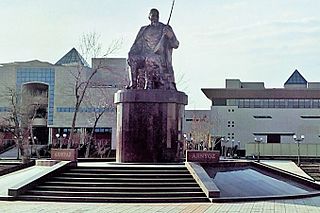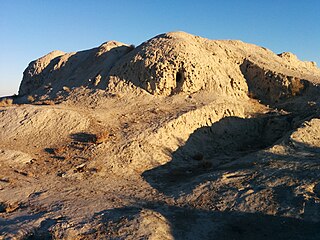Contents
This is a list of museums in Uzbekistan.
This is a list of museums in Uzbekistan.

Tashkent or Toshkent, historically known as Chach, is the capital and largest city of Uzbekistan. It is the most populous city in Central Asia, with a population of 2,909,500 (2022). It is located in northeastern Uzbekistan, near the border with Kazakhstan. Tashkent comes from the Turkic tash and kent, literally translated as "Stone City" or "City of Stones".
The music of Uzbekistan has reflected the diverse influences that have shaped the country. It is very similar to the music of the Middle East and is characterized by complicated rhythms and meters. Because of the long history of music in the country and the large variety of music styles and musical instruments, Uzbekistan is often regarded as one of the most musically diverse countries in Central Asia.

Termez is the capital of Surxondaryo Region in southern Uzbekistan. Administratively, it is a district-level city. Its population is 182,800 (2021). It is notable as the site of Alexander the Great's city Alexandria on the Oxus, as a center of Early Buddhism, as a site of Muslim pilgrimage, and as a base of Soviet Union military operations in Afghanistan, accessible via the nearby Hairatan border crossing.

Nukus is the sixth-largest city in Uzbekistan and the capital of the autonomous Republic of Karakalpakstan. The population of Nukus as of 1 January 2022 was 329,100. The Amu Darya river passes west of the city. Administratively, Nukus is a district-level city, that includes the urban-type settlement Karatau.

The Amir Timur Museum is located in Tashkent, the capital of Uzbekistan. It opened in 1996, and is dedicated to the Turco-Mongol warlord Amir Timur (Tamerlane).
The Nukus Museum of Art, or more properly the State Museum of Arts of the Republic of Karakalpakstan named after I.V. Savitsky, is located in Nukus, Karakalpakstan. It possesses the world’s second largest collection of Russian avant-garde artworks, as well as galleries of antiquities and Karakalpak folk art. In total, there are more than 82,000 items in the museum’s collection. The museum was described by The Guardian as the Louvre of Uzbekistan.

The State Museum of History of Uzbekistan, previously known as the National Museum of Turkestan, was founded in 1876. It is located in Tashkent.

The Museum of Arts of Uzbekistan is the largest state art museum in Uzbekistan. Its permanent collection contains more than several thousands works, divided among four curatorial departments. The museum was established in 1918 as a Museum of People University and renamed as a Central Arts Museum later. It was named as Tashkent Art Museum in 1924 and finally Museum of Arts of Uzbekistan in 1935.
The Museum of Communication History in Uzbekistan, is a unique and the first museum in the history of Uzbekistan which is related to the communication technologies. It was established in 2009, and nowadays the museum became one of the most famous museums among Uzbek people.

The Alisher Navoi State Museum of Literature of the Academy of Sciences of Uzbekistan is a scientific-cultural, educational establishment which mainly focuses on collecting and researching the historical materials and objects which are related to Uzbekistan's history. The museum plays a role in the cultural development of young generations in Uzbekistan and it keeps various documents, manuscripts from the Middle Ages.

Museum of Victims of Political Repression in Tashkent — is a museum which tells the history of Uzbekistan during the time of the Soviet Union, in particular that of the people killed by the Soviet government at that time. The Museum is divided into 10 parts.

The Museum of Geology in Tashkent, Uzbekistan is a geology museum that shows and represents the wealth of mineral and geological resources in Uzbekistan, including valuable stones, minerals and archaeological and paleontological findings.
The Uzbekistan State Museum of Nature is the oldest museum operating in Uzbekistan. The museum's main purpose is to show the natural beauty of Uzbekistan and to help protect its environment. The museum features chronologically-ordered exhibits and seeks to educate visitors about Uzbekistan's geography through time.
Art Gallery of Uzbekistan is established in Tashkent city, after the Independence of Republic Uzbekistan, and became one of the most visited modern museums of local people in Uzbekistan.
The Tashkent Polytechnical Museum is an automotive museum in Tashkent, Uzbekistan. The museum provides technical and mechanical information about cars made from 1800 to 1900, focusing on the history of automobile technology and production in Uzbekistan and around the world. It is located in the Mirabad district of Tashkent.
The Museum of Health Care of Uzbekistan is in Uzbekistan. It was established in order to contribute information about the medicine and hygiene among the Uzbek people in an interesting way.
Tashkent Planetarium is one of the newest constructions in Uzbekistan, which is visited by local people and by tourists. Tashkent Planetarium provides visitors with the opportunity to look at outer space, even in the morning, and enlarge their knowledge about the cosmos and the whole universe.

Varakhsha, also Varasha or Varahsha, was an ancient city in the Bukhara oasis in Sogdia, founded in the 1st century BCE. It is located 39 kilometers to the northwest of Bukhara. Varakhsha was the capital of the Sogdian dynasty of the kings of Bukhara, the Bukhar Khudahs. It ultimately never recovered from the Muslim conquest of Transoxiana.

The State Museum of Culture History of Uzbekistan is a museum of history and culture in Samarkand.